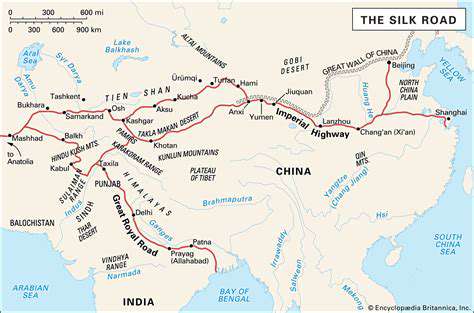The History of Tea: From China to the World
Across the Silk Road: Tea's Transmission to the West

Across the Ancient Trade Routes
The Silk Road, a network of interconnected trade routes spanning Eurasia, wasn't just about silk. It was a vital conduit for the exchange of goods, ideas, and cultures, and tea played a significant role in this vast tapestry of commerce. The journey of tea across these ancient pathways was a testament to the enduring allure of this beverage. The nomadic tribes and settled communities along the routes developed unique traditions surrounding tea consumption, shaping its cultural significance in diverse regions.
Early Adoption and Adaptation
As tea made its way along the Silk Road, its consumption and preparation evolved. Different cultures adapted the beverage to their own tastes and traditions, leading to variations in brewing methods and ingredients. This adaptation process enriched the tea experience, resulting in a wide array of regional styles. The journey from the tea-producing regions to distant markets fostered experimentation and innovation.
The Role of Merchants and Caravans
Merchants, vital players in the Silk Road's economic engine, played a crucial role in transporting tea across vast distances. Caravans, laden with precious cargo, risked perilous journeys across mountains and deserts to deliver tea to consumers in far-flung cities. These arduous journeys often took months, highlighting the dedication and resilience of the traders involved. The journey was fraught with risks, but the potential rewards were immense, driving the trade forward.
Cultural Exchange and Tea Ceremonies
The exchange of tea along the Silk Road wasn't just about trade; it was about cultural exchange. As tea traveled, so did the customs and rituals surrounding its consumption. Tea ceremonies emerged as a way to connect individuals from different cultures. These ceremonies became significant social events, offering a platform for dialogue, diplomacy, and the sharing of knowledge.
Tea's Impact on Cuisine and Society
Tea's presence on the Silk Road profoundly influenced culinary practices and social customs. Local recipes and ingredients were often integrated into tea preparation, creating unique blends and flavors. The social significance of tea became deeply intertwined with daily life. Its role in social gatherings, business dealings, and even religious practices demonstrated its societal impact.
The Legacy of Tea Across Continents
The Silk Road's influence on tea's journey across continents is undeniable. The trade routes facilitated the spread of tea cultivation and consumption to new regions, significantly impacting the cultural and economic landscapes. Tea's enduring appeal across diverse cultures is a testament to the Silk Road's legacy of cross-cultural exchange. The story of tea along the Silk Road continues to inspire fascination and appreciation for the beverage's rich history.
One of the most common causes of occipital neuralgia is irritation of the occipital nerves. These nerves, which originate in the upper part of the neck and travel to the scalp, can be irritated by a variety of factors. This irritation can lead to a sharp, stabbing pain in the head and neck, often accompanied by muscle tension and tenderness. The pain is typically located at the back of the head and can radiate to the temples and the top of the head.
From Plantation to Cup: Modern Tea Culture and Evolution
The Early Days of Tea Cultivation
Tea's journey from its origins in the misty mountains of ancient China to the bustling tea houses of modern society is a fascinating odyssey. The earliest documented evidence of tea cultivation dates back centuries, with the practice evolving from a medicinal elixir to a social staple. Early farmers painstakingly cultivated tea plants, nurturing them in specific microclimates to achieve optimal growth. This meticulous process, passed down through generations, laid the foundation for the elaborate tea ceremonies and traditions that would emerge later.
The cultivation techniques and the understanding of tea's properties were not static. As knowledge spread, so too did the methods for processing and preparing the leaves. Early methods, while different from modern techniques, reflected a deep respect for the plant and its potential. This initial period saw the emergence of tea as a drink associated with specific rituals and social gatherings, signaling a shift from a purely medicinal use to a more social and cultural one.
The Spread of Tea Across Continents
The journey of tea across continents was a gradual process, spurred by trade routes and the growing allure of this unique beverage. From China, tea's popularity gradually spread to other parts of Asia, influencing local customs and traditions. Merchants and travelers played a vital role in this dissemination, carrying tea across vast distances and introducing it to new cultures. The arrival of tea in Europe marked a significant turning point, as it fueled new trade networks and sparked a craze for this exotic drink.
As tea traveled, its preparation and consumption were adapted to local preferences and resources. This adaptation, in turn, led to a proliferation of tea varieties and brewing techniques. The unique characteristics of different regions, from the mountainous slopes of the Himalayas to the coastal regions of Southeast Asia, influenced the specific flavors and aromas of the resulting tea.
Modern Tea Culture and Innovation
In the modern era, tea has evolved into a globally recognized beverage, enjoyed by millions daily. Today, tea is no longer confined to traditional ceremonies or specific cultures. Instead, it has become a staple in countless households, enjoyed in various forms and flavors. The global tea trade continues to flourish, with a wide array of blends and specialized types catering to diverse palates.
Modern tea culture is marked by a sophisticated understanding of the nuances of different tea types. This understanding extends beyond simple brewing techniques to encompass the environmental conditions of cultivation, the processing methods, and the specific characteristics of each type of tea. From the delicate flavors of white tea to the robust character of black tea, the exploration of tea continues to inspire innovation and discovery.
The Evolution of Tea Brewing and Ceremony
The evolution of tea brewing and ceremony mirrors the broader societal changes that have occurred over the centuries. Early tea ceremonies were often elaborate rituals, steeped in tradition and symbolism. These rituals often served as a way to connect with nature and express respect for the tea plant. Over time, these ceremonies have adapted to different cultures and contexts, becoming more accessible and personalized.
Modern tea brewing techniques are diverse and sophisticated, reflecting a deep appreciation for the nuances of different tea types. From the precise steeping times for delicate white teas to the bold infusions of black teas, each type requires a specific approach to maximize its flavor profile. The ongoing evolution of tea brewing reflects a commitment to preserving tradition while embracing innovation.
Read more about The History of Tea: From China to the World
Hot Recommendations
- Traditional Foods for Day of the Dead
- Food Etiquette in Italy: Pasta Rules!
- Best Family Friendly Restaurants with Play Areas in [City]
- Review: The Best [Specific Dessert] Place in [City]
- Top Ice Cream Parlors in [City]
- Traditional Foods for Halloween
- The History of the Potato in Ireland
- Best Vegan Pizza Joints in [City] [2025]
- Best Bakeries for Sourdough Bread in [City]
- Food Culture in Argentina: Asado and Wine

![Best Vegetarian Restaurants in [City]](/static/images/28/2025-05/LocalFavoritesandHiddenGems.jpg)

![Review: [Specific Food Stand/Stall Name] Street Food Gem](/static/images/28/2025-05/ValueforMoney3AAStealofaDeal.jpg)

![Review: The [Specific Brand] Electric Kettle](/static/images/28/2025-05/BuildQualityandDesign3AALookBeyondtheBoil.jpg)


![How to Choose Sustainable Seafood [A Quick Guide]](/static/images/28/2025-06/WhySustainableSeafoodMatters.jpg)


